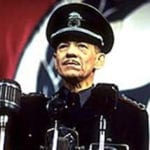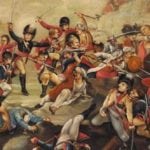 Animals
Animals  Animals
Animals  Weird Stuff
Weird Stuff 10 Weird Things People Used to Do at New Year’s
 Our World
Our World 10 Archaeological Discoveries of 2025 That Refined History
 Weird Stuff
Weird Stuff 10 Fascinating Facts You Might Not Know About Snow
 Miscellaneous
Miscellaneous Top 10 Things Crypto Was Supposed to Change & What Actually Did
 History
History 10 Huge Historical Events That Happened on Christmas Eve
 Music
Music 10 Surprising Origin Stories of Your Favorite Holiday Songs
 History
History 10 Less Than Jolly Events That Occurred on December 25
 Weird Stuff
Weird Stuff 10 Funny Ways That Researchers Overthink Christmas
 Politics
Politics 10 Political Scandals That Sent Crowds Into the Streets
 Animals
Animals 10 Species That Refused to Go Extinct
 Weird Stuff
Weird Stuff 10 Weird Things People Used to Do at New Year’s
 Our World
Our World 10 Archaeological Discoveries of 2025 That Refined History
Who's Behind Listverse?

Jamie Frater
Head Editor
Jamie founded Listverse due to an insatiable desire to share fascinating, obscure, and bizarre facts. He has been a guest speaker on numerous national radio and television stations and is a five time published author.
More About Us Weird Stuff
Weird Stuff 10 Fascinating Facts You Might Not Know About Snow
 Miscellaneous
Miscellaneous Top 10 Things Crypto Was Supposed to Change & What Actually Did
 History
History 10 Huge Historical Events That Happened on Christmas Eve
 Music
Music 10 Surprising Origin Stories of Your Favorite Holiday Songs
 History
History 10 Less Than Jolly Events That Occurred on December 25
 Weird Stuff
Weird Stuff 10 Funny Ways That Researchers Overthink Christmas
 Politics
Politics 10 Political Scandals That Sent Crowds Into the Streets
10 Disturbing Examples Of Musical Propaganda
Music has been shown to have a very real effect on the human psyche. Various governments and groups have used music to exert a psychological effect on people. Some of these efforts were highly effective, while others were never going to be big hits in spite of their best efforts.
10 Westboro Baptist Church Song Parodies
The hateful Christian sect known as the Westboro Baptist Church (WBC) is usually noted for its hate speech and bad-taste protests, but it also spreads its message via music. Specifically it parodies pop music songs and videos and spreads the parodies through YouTube as well as a SoundCloud with over 100 songs, which are mostly madness-inflamed variations of pop and traditional music. The parodies are bizarrely faithful to the sound of the original songs, making you feel like you’ve fallen into a parallel universe where Weird Al Yankovic is a virulent homophobe, Katy Perry is predicting the apocalyptic death of sinners, and Lorde is asserting that the members of the WBC will rule in Heaven with Lord Jesus while the rest of the population burns in hell.
They seem to have a particular axe to grind with Lady Gaga, having dedicated two song parodies to her. In the first, the original “Telephone” becomes “Ever Burn,” a reference to Lady Gaga’s eternal, fiery damnation. The second was a parody of “Poker Face” featuring the chorus, “You pissed off God, you’ll see what he’s got.”
Some believe that the songs represent a way for WBC members to engage with the mainstream culture that they claim to despise. There are also those who say while the WBC usually prefers to get attention in a negative way through trolling and viciousness, the song parodies reveal that maybe they just want to be liked after all. The only problem is that their desperate attempts to look hip and cool tend to look ridiculous.
In 2014, the WBC parodied Panic! at the Disco’s 2006 single “I Write Sins Not Tragedies,” remaking it as “You Love Sin What a Tragedy,” with lyrics like:
Oh! You all say it’s okay to be gay
The way to fag marriage has been paved
Well this calls for some truth, now
You’re all insane.
Panic! at the Disco took revenge when the WBC planned to picket a concert by promising to donate $20 to pro-gay rights group Human Rights Campaign for every member of the WBC that showed up. They duly agreed to pledge $260 when only 13 WBC members actually showed up, later rounding it up to a flat $1000.
9 ISIS Nasheeds
One method used by ISIS to recruit impressionable Muslim youth is through pro-jihadi songs known as nasheeds. These a cappella Arabic chants are sung by men and provide the background music for ISIS militant actions in the Middle East. Pro-jihadi nasheeds first emerged among Islamic fundamentalists in Egypt and Syria in the 1970s, growing in popularity in spite of some denouncing them as un-Islamic.
Today, ISIS is churning out thousands of these songs. The most popular is “My Ummah, Dawn Has Appeared,” the unofficial ISIS anthem, which features lyrics such as, “The Islamic State has arisen by the blood of the righteous. The Islamic State has arisen by the jihad of the pious.” Some of the songs are originals, but others are traditional and familiar religious songs remade as odes of jihadism. These allow for catchy tunes that are appealing to the young, particularly those from the West, as well as nostalgic tunes appealing to older generations, all supporting and reinforcing the agenda of the Islamic State.
The songs are made quickly in rudimentary basement studios using basic recording equipment, Auto-Tuned verses, and a range of militant sound effects like marching, horses’ hooves, and gunfire. This is a convenient way to create music without actual musical instruments, which are forbidden by ISIS’s strict interpretation of Islam. The Islamic State has a dedicated nasheed-producing wing called the Ajnad Media Foundation, which combines the efforts of poets, musicians, and militia performers, including an increasing number of Westerners such as German ex-rapper Deso Dogg.
Nasheeds are also popular among Shia Muslim groups, which lack the Sunni restrictions on instrumentation and dancing. Shia nasheeds are filled with rhythmic drumming, stringed instruments, and Auto-Tuned singer-dancer troupes that sound more like techno boy bands than traditional Islamic music.
8 Gunka
The Imperial Japanese produced thousands of militarist songs, known as gunka, designed to whip their population into a warlike frenzy. The military songs first developed in the late 19th century as Western instrumentation was combined with both Western and Japanese music styles to create a fusion brass band marching music. These songs became the soundtrack of rising Japanese power, popular especially during the Russo-Japanese and Sino-Japanese War periods.
By the 1930s, the production of gunka was heavily encouraged by both the Ministry of Information and the Ministry of Education. However, the invasion of Manchuria saw a boost to the genre, with a rise in appreciation for the classics of earlier wars and a boom of new songs like “Kogun shinpatsu no uta” (“The Imperial Army Marches Off”) and “Manshu no rabaa Manshu musume” (“Manchurian Maiden, my Manchurian Lover”).
Japanese records labels encouraged citizens to write their own patriotic war songs, and the content became increasingly radicalized. These included “Bakudan Kurai Te de Ukeyo” (“You Can Catch the Bomb”), “Aikoku Koushin Kyoku” (“The Nationalism March”), and “Umi Yukaba” (“If You Go to the Sea”). The music was designed to be catchy, slow enough for anyone to sing along to, and have a compelling beat.
“Umi Yukaba” featured particularly garish lyrics, but is considered a classic of the genre:
If you go to the ocean,
there is a drenched cadaver.
If you go to the mountain,
there is an overgrown cadaver.
There was even a gunka written in honor of a visit by a Hitler Youth representative to Japan in 1938, called “Banzai Hitler Youth!”
The Hakenkreuz
Waves gloriously.
The industry and patriotism are also our spirits.
You, glorious Germanic race,
Now master Japanese spirit
Through our mountains and rivers!
Banzai Hitler Youth!
Banzai NSDAP!
The musical style was banned following Japan’s defeat in 1945, but its influence persisted in Japanese popular music through the rest of the century. Today, these songs are extremely popular among far-right Japanese, who blast gunka from the loudspeakers of roaming campaign vans, and is sometimes played for elderly people in retirement homes who were suffering from dementia. Bizarrely, it has enjoyed a 21st-century revival among fans of a trend of militaristic anime and smartphone games called moe-miritari, which often features young anime girls fused with military weaponry and a gunka soundtrack.
7 IRA Rebel Music
Irish rebel music is a subgenre of Irish folk music with lyrics about Irish republicanism. For Irish nationalists, these songs are a source of national pride and a reminder of their struggle for independence against British imperialism and oppression. But some of the songs have been condemned for their idolization of republican terrorism, including the murder of British soldiers and police. While songs are a rightful part of any national tradition, particularly when the fight for nationhood has been difficult, some, particularly Loyalists in the North, believe that some of the songs are used to glorify the actions of modern-day terrorist groups.
In 2014, the Irish rebel band The Druids caused controversy at the Ardoyne Fleadh festival in north Belfast for their comments about British soldiers: “It’s about time that they took down their little Union jacks, it’s about time that they got all their Orange comrades together, it’s about time that they loaded up the bus and it’s about time that they all f—ed off back to England where they came from.” This was received with cheers from the crowd.
This soon led to complaints by loyalists that the band was promoting anti-British and anti-Protestant hate speech, while the band said that the comments were taken out of context and represented the band’s support for a united Irish Republic but not IRA terrorism.
In 2015, a judge in Scotland ruled that such songs were “threatening and offensive” following the conviction of two men for singing a pro-IRA song at a football match. They were arrested under the Offensive Behaviour at Football and Threatening Communications (Scotland) Act, a controversial piece of legislation designed to reduce sectarian violence at football matches but criticized by some as a restriction on freedom of speech.
Lord Justice Clerk Carloway explained his position: “There is no blanket ban on singing sectarian songs and the appellants are at liberty to indulge their desire to do so at many alternative venues. There is, however, a prohibition on doing so at football matches . . . type of conduct here is precisely what the law is aimed at.”
6 Chinese Revolutionary Operas
Beijing opera, or jingju, is a musical form dating back to the 18th century, with earlier operatic forms dating all the way back to the Tang dynasty a millennium earlier. With the rise of the Chinese Communist Party (CCP), this decadent and feudal form of entertainment had to go, but it had a replacement. While in the Soviet Union, traditional opera went mostly defunct following the rise of Communism, and the Chinese actively developed pro-communist revolutionary operas for the entertainment of the people.
The first revolutionary operas were crude prototypes performed for Mao Zedong at Yenan in 1938, focusing on the CCP struggle against the Japanese invaders but lacking the finesse and talent of traditional opera. Initially, the traditional costumes were kept in a weird mix of traditional styles and modern themes. Mao wasn’t satisfied and established cultural institutes to further refine the art form. One traditional opera, The Fisherman’s Revenge, was refined as communist propaganda, with the traditional garb giving way to modern clothes. Interest began to wane in the 1940s as squabbles erupted over whether traditional opera was reactionary decadence or valuable cultural heritage.
Mao would cut through the controversy, declaring that the real objective was “to make art and literature a component of the whole revolutionary machine, to make them a powerful weapon for uniting and educating the people, and for attacking and destroying the enemy, and to help the people fight with one heart and one mind.” This would help lay the foundation for the development of the yang ban xi, eight operas and two ballets meant to serve as a cultural means of political education. While traditional operas were based on Confucian ideals of filial piety and social harmony, the revolutionary operas preferred to idolize Mao Zedong and the rule of the Communist party.
It was Mao’s wife, former actress Jiang Qing, who took the forefront of yan ban xi development, which often involved remaking traditional Beijing operas with revolutionary themes. The Red Lantern, Taking Tiger Mountain by Strategy, Sha-Jia Pond, The Harbor, Raid on White Tiger Regiment, Red Detachment of Women, and Song of Dragon River all received the yan ban xi treatment. During the cultural revolution, these operas were distributed and performed throughout the country, made into movies, and advertised on omnipresent posters. The fact that all other music and performance was banned helped these operas to leave a permanent mark on the people who lived through the Cultural Revolution, many of whom remember those days with a decidedly mixed nostalgia.
5 Narcocorridos
Corridos are a Mexican musical tradition dating back a century, based on polkas and waltzes and featuring lyrics backed by accordions and brass bands. They first gained popularity during the Mexican Revolution, celebrating notables like Pancho Villa and Emiliano Zapata. Over the last 30 years, the rise of powerful drug cartels in northern Mexico has seen the development of narcocorridos, celebrating the exploits and outrages of the drug cartels, their leaders, and their soldiers. While the Mexican government has made efforts to have the music banned, their popularity remains strong.
Many of the lyrics glamorize the violence inherent in the cartels, such as a song written by narcocorrido group El Movimiento Alterado in honor of a Sinaloa cartel chief, with a accordion-backed chorus chanting, “We like to kill,” and more detailed lyrics:
With an AK
and a bazooka taking aim
blowing off the heads
of whoever gets in the way
The music is extremely popular, a cultural reaction to violent power of the cartels, and musicians who wish to make an income are forced into the genre. As one guitarist told NPR, “The people say, ‘Sing me a corrido about narcos with bullets and marijuana.’ They don’t want a bolero. They want a narcocorrido. That’s how it is here on the border.”
Today, the world of narcocorrido musicians has become increasingly dangerous, as singers and performers get caught in the crossfire of jealous cartel struggles. The first high-profile singer to die was Chalino Sanchez in 1992, and dozens more have died since. In 2015, 20-year-old singer Alfredito Olivas was shot eight times while performing in a nightclub, while 22-year-old singer Rogelio Brambila Lizarraga was found dead in an SUV riddled with bullets.
One independent promoter explained to Billboard: “It’s like a horror movie. Artists get killed because they played at a party for a [rival] drug dealer; because they looked at a dealer’s girlfriend; because they get paid to write or record a song about one dealer and a rival gets upset; or because they somehow piss off the dealer who’s funding their career.”
But the music is popular, and fame is seductive in spite of its dangers: “Think about it. You’re a young artist and someone offers you $100,000 to record a song and make it a hit. It goes to No. 1, and suddenly Univision and Telemundo are battling for you.” But the cartel leaders like notoriety even more than fame, and one good way to get that is by killing off a popular narcocorrido singer who steps out of line.
4 Reichsmusikkammer
Nazi Germany had a desire to create a pure German cultural world, which was the purview of one of the central government organs, the Reichskulturkammer (RKK), or Reich Chamber of Culture. The musical division of the RKK was the Reichsmusikkammer (RMK), meaning Reich Chamber of Music. According to composer Richard Strauss, this was “the dream and goal of all German musicians for decades” and “an important step in the direction of the reconstruction of our total German musical life.” It was probably a surprise to Strauss when the Reichsmusikkammer banned his music in 1935, probably due to Jewish members in his family.
The name of the game was “good German music,” which Hitler and Goebbels believed was best represented by Ludwig van Beethoven, Richard Wagner, and Anton Bruckner. Hitler identified himself with the “strong German” Beethoven, loved the serious Teutonic compositions of Wagner, and saw in Bruckner a representative of the honest, humble roots of the German people at large.
Other “good German” artists included Hans Hotter (whom Hitler called “the baritone of the future” even though Hotter allegedly made fun of him at parties), Clemens Krauss (to whom Hitler took a weird liking and forced to work for the music ministry in Munich in spite of his only wanting to return to Vienna), and Elly Ney (a former child prodigy who was virulently anti-Semitic, a feeling dating back to a hated Jewish piano teacher when she was 10 years old).
In late 1937, RMK Director Peter Raabe declared, “All foreign music that shall be distributed in Germany by music publishers must be submitted to the Music Inspecting Authority of the Reich Propaganda Ministry. It is prohibited to distribute sheet music that has been declared as unwanted by the Music Inspecting Authority.” It took a couple of years, however, before a comprehensive censorship policy on music was fully in place, prohibiting “music whose composers, lyricists, arrangers, or publishers are Jews or members of enemy states (England, Poland, Russia, France; Bizet-Carmen and Chopin are exceptions).”
Musical propaganda was an important part of the Hitlerjugend, or Hitler Youth movement, most particularly group singing. An internal memo described the importance: “[It is] precisely during celebrations and singing events [that] we have an excellent opportunity to have a political effect wide beyond the typical formation . . . Songs possess the strongest community-building power. Thus we use them deliberately at those moments when we want to waken the consciousness of being part of a community, in order to deepen the power of such an experience.”
Music was seen as a way to increase group cohesion and loyalty, and Hitler Youth children were given regular vocal and instrumental music lessons as part of their core curriculum. Hitler Youth members commonly performed at festivals and the birthday parties of senior Nazi officials.
3 The Khmer Rouge War On Music
Following independence from France in late 1953, the Cambodian capital of Phnom Penh was home to a thriving music scene, which took influence from Western records imported from France but made it their own. When the US military was stationed in Vietnam in 1965, Cambodian musicians were exposed to American rock, blues, soul, and pop via a branch of Armed Forces Radio. A generation of vibrant Cambodian rock musicians emerged. They were largely destroyed by the Khmer Rouge.
When the radical leftist group took the capital in 1975, they immediately embarked on a bloody campaign to rid the city of any Western influence, exiling or executing educators, lawyers, doctors, and other intellectuals. But they had a particular ire for singers, songwriters, and musicians, whom they saw as the primary representatives of a corrupt, Westernized culture that they sought to scatter to the winds. Forced to leave, many musicians perished in the resulting famine, with a few survivors agreeing to play propaganda music for the regime.
The new Khmer Rouge revolutionary music was designed to indoctrinate the population, with all forms of prerevolution popular, folk, and traditional songs and dances banned. These were intended as a form of cultural warfare, to destroy the arts of “the enemy” and build the revolutionary spirit of the people.
“The Red Flag,” a song sung before meetings, represents the general tone of music under the Khmer Rouge:
Our Red Flag of the Revolution
Glittering red blood blankets the earth, Sacrificial blood to liberate the people:
Blood of workers, peasants and intellectuals;
Blood of young men, Buddhist monks, and young women.
Blood that swirls away and takes flight, twirling on high
Into the sky,
Turning into the red, revolutionary flag!
Since the fall of the Khmer Rouge, prerevolutionary music has enjoyed a revival both at home and among the Cambodian diaspora. In 2015, a documentary entitled Don’t Think I’ve Forgotten: Cambodia’s Lost Rock and Roll detailed the harrowing and horrifying experience under the Khmer Rouge from the point of view of musicians. They paint a vivid picture of a desolate and postapocalyptic Phnom Penh, with record shops smashed and musical instruments lying abandoned in bloodstained streets.
2 Mbare Chimurenga Choir
Music has always played an important part in Zimbabwean political history. In the colonial period, black musicians made compositions in favor of freedom and revolution, which were quickly banned and suppressed by the white supremacist government but popular nonetheless. The Zanu PF fighting for black independence played militant music through a pirate radio station known as Voice of Zimbabwe. After black independence, music was free of censorship, and big international acts like Bruce Springsteen and Bob Marley toured the country.
Things changed when musical acts emerged in the 1990s that were critical of Robert Mugabe and the Zanu PF regime. They then cracked down on “politically incorrect” music, banning it from the media airwaves, and tried to replace it with regime-friendly propaganda pieces. They funded the production of records by artists deemed friendly or harmless to the regime and promoted political jingles called chave chimurenga (“it’s now war”) music.
One of the chief organs of Zanu PF propaganda music was the Mbare Chimurenga Choir, a 67-member group of men and women, said to be fruit and hardware vendors, who are known for their enthusiastic dancing and pro-government lyrics. They were popular but also benefited from serious government support.
One analyst described the group as being designed to produce “partisan songs that propagandistically glorify Mugabe [and] enjoy prime-time airplay (and those songs that demean him are censored). Youths appear to be the target of such songs as the theme, singers and dancing style appeal to the younger generation. The setting of the songs, though cross-cutting the rural and urban divide, leans heavily towards violence, suggesting that the party which traditionally enjoys support from rural areas may be taking the war of violence to the suburbs.”
In late 2010, Information and Publicity Minister and Zanu PF Political Commissar Webster Shamu ordered the DJs on four Zimbabwe Broadcasting Corporation radio stations to play at least two pro-government jingles per DJ session, roughly every 30 minutes. The jingles were delivered by Shamu on a Mbare Chimerenga CD entitled Nyatsoterera (Listen Carefully), and he emphasized the heavy rotation of the song “Ndikusetere team,” a jingle extolling Robert Mugabe as the head of the Zimbabwe “team” and condemning opposition leaders.
The heavy push on musical propaganda was in preparation for elections the following year. It continued in 2011 in spite of an earlier agreement for an inclusive government with the MDC party. Zanu PF organized a rally outside the Munhumutapa Building government offices with an all-day Mbare Chimurenga performance, annoying and distracting the officials working inside. Since then, however, the group’s popularity has declined as Mugabe ages; missiles were thrown at the group by a crowd during a performance in 2015.
1 White Power Hip-Hop
The modern neo-Nazi movement has a complex relationship with hip-hop, with some rejecting it entirely as antithetical to the whole point of the movement and others arguing that it could be a potential tool to spread awareness. Strangely enough, white supremacist hip-hop is a phenomenon that exists around the world.
The LA Times called attention to an American manifestation of white power rap in 2006 in an article about the hip-hop group Woodpile. The Times described the group as “heavy-set men sporting shaved heads and covered with tattoos. They pump their fists in the air and dance raucously in front of a stage festooned with Nazi flags and racist skinhead symbols. Others, including a few women, watch around the perimeter. Onstage, people are playing deafening music, shouting more than singing, with lyrics urging white people ‘to stand up and fight.’ ”
The band would later claim that they were a white pride group, not a white power group. That logic was enough to convince one staff writer at the Southern Poverty Law Center:
First and foremost, they’re on West Coast Mafia Records. Bottom line? Even if it’s dollars and you can rationalize something like that, I can’t see a black gangsta guy putting a white supremacist rapper or music artist on his label. I can’t see a white supremacist wanting to be subjugated to being on a black guy’s record label. It kind of subverts the racial hierarchy philosophy of white supremacists. I couldn’t even find this ‘proud to be white’ flavor. There’s nothing wrong, criminal, or anything even racist to say ‘we’re white and we’re proud.’
Things are more clear-cut in other parts of the world. In Germany, hip-hop was introduced to the neo-Nazi community when a rap duo from New York released a limited release album named Neo Hate, which received attention from the Brandenburg-based German skinhead fanzine Der Panzerbar. This soon led to an eruption of neo-Nazi rappers in the country. They distribute their mix CDs in schoolyards in the hope of influencing impressionable youth. These artists include N’Socialist Soundsystem (the “N” stands for “National”), Sprachgesang zum Untergan, Naturlich, and solo artists MC Bock and Makss Damage.
Many of the German artists even deny being hip-hop artists at all, making a number of justifications for the dissonance between their music and their ideology. Makss Damage said, “I turn black music into white music—like Elvis did back in the day,” while N’Socialist Soundsystem makes their position pretty clear: “Your rap is dead, conform to the system, the true German wave is about to come with N’Socialist Soundsystem, I despise you, you are conform and cowardly, I never liked you, f— you, system-pigs.”
Other examples of white supremacist rap have turned up in Russia, France, and allegedly Poland, though we couldn’t find any examples. All in all, it seems a pretty demonstrable denunciation of a supremacist movement if you end up culturally absorbed by the very group you hate so much.
David Tormsen is now an unwilling fan of several of these forms of music, but he’ll never tell you which. Email him at [email protected].








